Urine scald in dogs can be a persistent and painful problem—especially for senior dogs, paralyzed dogs, or those with urinary incontinence. But integrative veterinarian Dr. Julie Buzby is here to help. She explains why dogs get urine scald, what urine scald looks like, and how to treat and prevent urine scald.

As a veterinarian with a special passion and soft spot for senior dogs, I often treat senior dogs who are facing some challenges that aren’t as common in their younger counterparts. One such condition is urine scald.
My patient, Annabelle, a 10-year-old Beagle mix, had suffered several orthopedic injuries in her younger days. As she aged, resulting arthritis made it increasingly difficult for her to get up and go outside. Plus, she had started to experience fairly significant urinary incontinence.
This combination of spending more time lying down, and leaking urine turned out to be the perfect storm for urine scald.
What is urine scald in dogs?
As I looked at Annabelle’s skin, I was reminded of why urine scald is also called urine burn. The skin on her belly and hind legs were bright red—almost like she had a sunburn. And it was painful for her too. Prolonged contact with urine—or more specifically the ammonia in the urine—had quite literally scalded her skin.
Thankfully, Annabelle had a fairly uncomplicated case of urine scald. However, as I mentioned to my client, the other problem with urine is that as it sits on a dog’s skin, it weakens the skin’s natural protective barriers. As a result, the dog can develop a bacterial skin infection (i.e. pyoderma in dogs) secondary to the urine burn. Plus, by weakening the skin, urine scald also increases the chances of pressure sores in dogs.
What does urine scald look like on a dog?
The appearance of the scalded skin can vary a bit depending on how severe the urine scald is and whether or not the dog also has a skin infection or pressure sores. But in general, urine scald symptoms include:
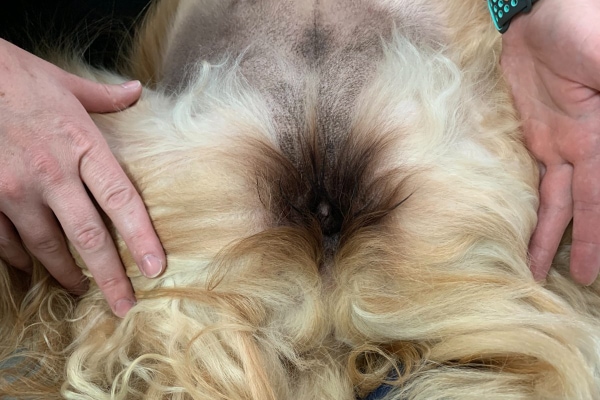
- Red, irritated skin—especially around the belly, groin, and hind legs
- Rash or bumps on the skin
- Increased moisture of the skin and haircoat
- Unpleasant odor associated with the affected area
- Increased licking or chewing of the skin
- Signs your dog is in pain
- Crusts or sores on the skin
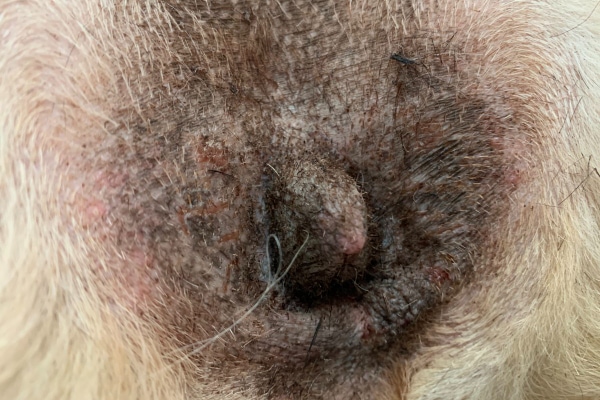
Plus, before you see signs of urine scald, you may see evidence your dog is leaking or dribbling urine or having urinary accidents. Signs include:
- Wet spots on your dog’s bed or blankets
- Increased licking around the vulva or prepuce
- Moisture on the fur and skin around the vulva, prepuce, belly, or hind legs
What makes dogs prone to urine scald?
To be clear, not every dog who leaks urine or has urinary accidents will develop urine scalding. But if the urine sits on the dog’s skin for long periods of time, it can (and does) burn the skin.
This raises the question of what might lead a dog’s skin to be in prolonged contact with urine. Well, as it turns out, these dogs tend to have urinary incontinence plus decreased mobility or even paralysis.
Incontinence
Dogs with urinary incontinence (i.e. an inability to control urination) often dribble urine where they are lying down and may not realize it. Sometimes the urine can be in contact with the dog’s skin for a long time, especially if the dog isn’t moving around much.
There is a range of causes of urinary incontinence in dogs, including:
- Bladder stones
- Weak bladder sphincters (sometimes develops as a dog ages)
- Certain medical conditions (e.g. kidney failure in dogs, hypothyroidism in dogs, diabetes mellitus, Cushing’s disease in dogs)
- Low sex hormones in spayed female dogs
- Bladder cancer in dogs
- Urinary tract infections (UTIs in dogs)
- Enlarged prostate in dogs
- IVDD in dogs or other neurological conditions that lead to weakness or paralysis
Poor mobility or pain
Incontinence is especially a problem when the dog also has poor mobility due to pain or injuries. Not only do these dogs not always notice they are lying in urine, but also they might not be very likely (or able) to get up, change positions, or move to a dry location.
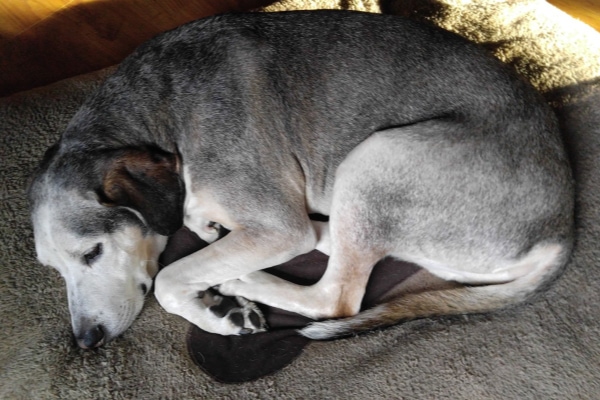
However, lying in puddles of urine can also happen to dogs who aren’t incontinent. For example, painful dogs might be less motivated, or unable, to move from their sleeping spot in order to urinate. Therefore, they may simply urinate where they lie.
Mobility-altering conditions that may predispose a dog to urine scalding include:
- Osteoarthritis in dogs
- Injury or trauma (e.g. hit by a car or a broken leg)
- Recent surgery
- Blindness
- Neurologic conditions (e.g. stroke in dogs and vestibular disease in dogs)
Paralysis or spinal cord injury
Paralyzed dogs often have two strikes against them. They are dealing with urinary incontinence and they probably can’t move out their own urine even if they wanted to. These dogs often leak urine for the same reasons they can’t walk—spinal cord damage.
Several nerves that exit the spinal cord are responsible for helping the bladder fill (i.e. retain urine) and then release that urine (i.e. urinate). For example, one nerve controls the opening and closing of the urethral sphincter (i.e. valve that regulates the flow of urine from the bladder to the urethra). Plus, other nerves tell the bladder muscles to contract or relax to help the bladder fill or to initiate the flow of urine.
If a dog suffers from a spinal cord injury that affects these nerves, he or she may be unable to voluntarily control urination. This can lead to urine leaking and/or the need for a dog parent to manually express the bladder. Unfortunately, the end result may be a dog who spends a lot of time lying in urine.
Wet diapers or belly bands and soiled bedding
As we will discuss in a bit, diapers and belly bands (which wrap around a male dog’s abdomen to cover the penis) can sometimes help prevent urine scald. However, they can also cause a urine rash. Think about it this way. Babies can get diaper rash if they are left in dirty diapers for too long. And your dog can develop urine scald from his or her wet diaper or belly band.
Along the same lines, sometimes your dog may urinate on the bedding and you don’t realize it. Or maybe something happened and you aren’t able to change out the wet blankets as quickly as normal. As a result, the dog may spend a long time lying on urine-soaked bedding, which can start to damage the skin.
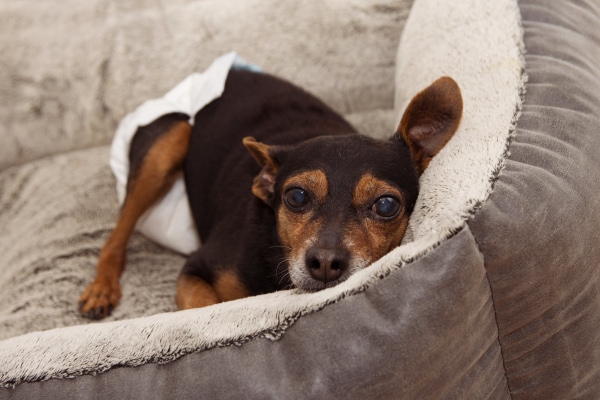
How can I prevent urine scalding?
If your dog is struggling with incontinence, poor mobility, urinary accidents, or any of the other issues that predispose dogs to urine scald, you may understandably want to know how to prevent your dog from getting urine scald.
Based on what you have learned about urine scald, it makes sense that the most important thing you can do is attempt to keep your dog clean and dry. I know this isn’t always an easy thing to do, so I want to share a few tips that might help.
1. Work with your vet to create a game plan
It probably goes without saying, but your vet is an invaluable resource when it comes to managing your dog’s urinary incontinence and/or mobility challenges. He or she can help you find the underlying cause(s) and work with you to create a treatment plan.
Depending on the cause of the incontinence, there are medications (e.g. Proin for dogs) and procedures that might help your dog achieve better bladder control. Or sometimes addressing the underlying UTI, metabolic disease, or bladder stones can solve the problem. Your veterinarian can discuss the various options with you and let you know which might be best for your dog’s situation.
Plus, he or she can help you find ways to improve your dog’s mobility and advise you about any other preventive measures that your dog may benefit from.
2. Line your dog’s bed with “pee pads”
The absorbent disposable pads made for pad-training puppies work great for dogs who are leaking urine or urinating while lying down. By absorbing urine as it dribbles out, these pads decrease the amount of urine that stays in contact with your dog’s skin.
They also make cleaning easier because you just pick them up and throw them away. And the plastic backing should keep the urine from leaking through to the bedding underneath, which cuts down on the amount of laundry you need to do.
As a word of caution, you do still want to ensure that you are changing the pad frequently. Lying on a saturated pee pad for a long time can still lead to urine scald.
3. Have your dog wear a diaper or belly band
Another way to absorb some of the urine is by utilizing dog diapers or belly bands. Typically, diapers work better for female dogs because they can effectively cover the vulva (i.e. cone-shaped area of skin between the hind legs where urine exits). Since a male dog’s prepuce (i.e. skin covering the penis) is typically located partially in front of the hind legs, traditional diapers may not work as well for them.
This is where a belly band comes in. There are a variety of types of belly bands on the market. But most of them are made up of fabric that fastens around a dog’s waist to cover the opening of the prepuce. Some are made to hold a disposable absorbent pad while others have absorbent material built into them.
Diapers or belly bands, when used properly, can be a great option for many dogs because they collect the urine so it doesn’t sit against the dog’s skin or soak the bedding. But I can’t stress this enough. It is very important to change your dog’s diaper or belly band regularly. Otherwise, it may actually increase the risk of urine scald.
4. Help your dog change positions frequently and get up to go outside
Another piece of the equation is keeping your dog from staying in the same position or location for a long time. If your dog is paralyzed or reluctant to get up from lying down, reposition him or her every two to three hours. Not only does that keep your dog from lying in urine for a prolonged time, but it also helps prevent pressure sores. Skin with urine scald is more prone to pressure sores, and pressure sores make the skin more susceptible to urine scald, so the two go hand-in-hand.
If your dog isn’t truly “down” but does have trouble with mobility, the following options might be helpful:
- Apply Dr. Buzby’s ToeGrips® dog nail grips to help your dog gain traction on the floor. This can make him or her more confident in moving from one resting place to another or heading to the door to go outside.
- Give your dog joint supplements for dogs like Dr. Buzby’s Encore Mobility™ hip and joint supplement to improve joint health and, therefore, mobility.
- Talk to your vet about pain medications and natural pain relief for dogs to decrease your dog’s pain levels.
- Use a GingerLead® Support and Rehabilitation Harness or Help ‘Em Up® Mobility Harness to help your dog get outside for bathroom breaks or relocated from room to room (or bed to bed).
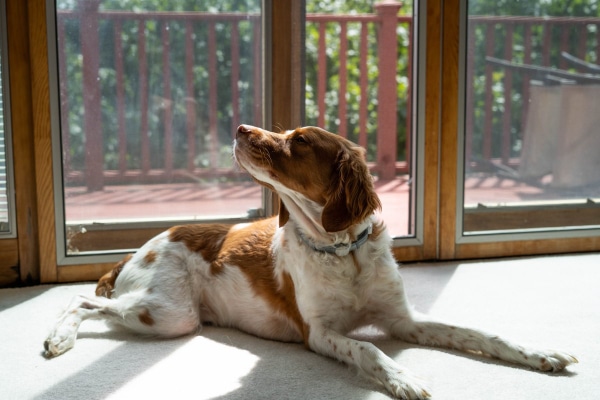
5. Increase the number of potty trips in a day
Additionally, some dogs can benefit from more chances to go outside to urinate. This might mean planning to take your dog out more frequently when you are home. Or if you are regularly away most of the day, you may want to hire a dog walker or ask a friend to take your dog out once or twice during the day.
6. Frequently check your dog’s fur and bedding for urine
Each time you take your dog outside or help him or her change positions or resting locations, get in the habit of checking your dog’s fur and bedding for urine. If your dog has urine on his or her skin or fur, clean it off with a warm, damp washcloth or baby wipes. Or give your dog a spot bath with a gentle shampoo. Then be sure to gently dry the area.
If the bedding is soiled, replace it with clean blankets or a fresh puppy pad. And change your dog’s diaper or belly band at this time too. Remember, the goal is to have urine in contact with your dog’s skin for as short a period of time as possible.
What if my dog already has urine scald?
Despite all of these preventive measures, sometimes dogs will still develop urine scald. If this happens, please don’t beat yourself up! It can be challenging to care for a dog with urinary incontinence and mobility issues. Your pup knows you love him or her and are doing your best.
If you suspect your dog has urine scald, the most important thing you can do is to have your dog seen by your veterinarian as soon as possible. The sooner urine scald is treated, the easier it will be to manage. And the less painful it will be for your dog.
Your vet will examine your dog to determine how extensive the urine scald is. Plus, he or she will also assess your dog’s overall health with a comprehensive physical exam. Then your vet may recommend some diagnostics to get to the bottom of why your dog is developing urine burns. Diagnostics may include:
- Bloodwork (chemistry panel, complete blood count, thyroid panel, etc.)
- Urinalysis (and possibly urine culture)
- X-rays or other imaging
- Skin cytology or culture
- Additional diagnostics as needed
What does treating urine scald in dogs involve?
As your veterinarian develops a treatment plan, he or she will likely focus on treating both the urine scald and the underlying condition. Treatment for the underlying problem will vary, so we won’t discuss it more here.
I do, however, want to mention some of the ways your vet may treat urine scald.
Skin care and cleansing
Typically, your vet will recommend gently cleaning up your dog with baby wipes, medicated wipes, or gentle shampoo each time the fur is soiled. If your dog has long hair, your vet may suggest trimming the fur in the problem areas too. This can help you keep your dog cleaner and allow better access to the skin for topical treatment.
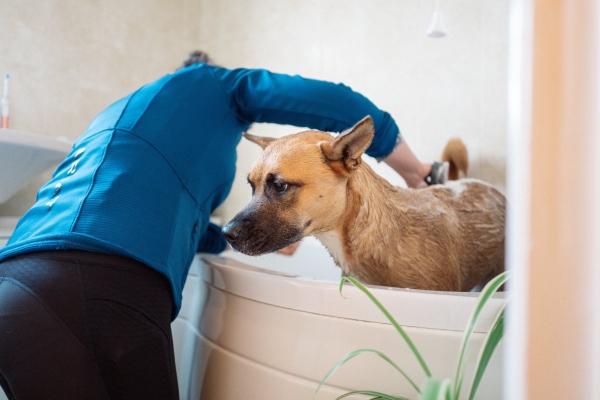
Topical products
Your vet may also recommend various products to apply to the skin, including:
- Barrier sprays like 3M Cavilon™ no sting barrier film to protect the skin
- Lanolin and/or petrolatum-based ointments like Vaseline®, Aquaphor®, or A&D Original Ointment to protect and heal the skin
- Cornstarch or cornstarch-based baby powder to dry out the moist areas
- Silver sulfadiazine cream to promote healing
When using these remedies, it is best to keep your dog from licking the affected areas. That way he or she doesn’t ingest the product or keep it from doing its job.
As a word of warning, you will notice that diaper creams like Desitin® are missing from the treatment list. Diaper cream is great for baby diaper rash but zinc oxide (the active ingredient in many diaper creams) can be toxic to dogs if ingested. For this reason, I typically caution pet parents against using zinc-based diaper creams on their dogs.
Systemic medications
Since urine scald can be painful, your vet may also prescribe oral medications to help reduce pain and inflammation. Also, if your dog has a secondary bacterial skin infection, the vet may recommend a course of antibiotics.
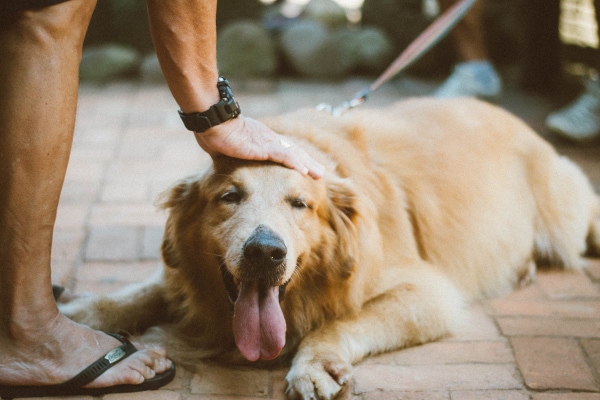
Don’t be discouraged
It can be challenging to take care of a dog who is struggling with incontinence, urinary accidents, paralysis, and/or poor mobility. Sometimes, despite your best efforts, your dog might develop urine scalding. It happens. And it doesn’t mean you are a terrible dog parent!
Please know that veterinarians recognize and appreciate how much time, effort, and love you give your dear companion. And they are here to help and support you in every way possible—be that discussing prevention and treatment strategies or providing a listening ear. Sometimes it takes a bit of time, patience, and trial and error to find the right combination of solutions. But you can successfully manage your dog’s urine scald.
Do you have tips that have helped prevent or manage your dog’s urine scald?
Please share them below.


Can you shave your dog to clear the hair around the vaginal ,and side of it, area? There is some scabbing there I believe caused by urine leaking. I have some medication to apply and cutting the hair won’t clear enough.
Hi Patty,
Yes! Removing the hair from these areas can be a big help when battling urine scald. I also will shave hair from the perianal area for dogs that have issues with feces getting stuck and dried into the hair. Most vets and groomers will be glad to help with this. We usually call shaving this hair a “potty patch”. Great question and keep up the good work!
Hello, I have a 4 year old femal Shepsky (Husky/German Shepherd mix) she’s spayed and had been very healthy up until 2022. In June of 2022 she developed a UTI which we treated with her vet; that UTI then came back 3 times in a row. Just a few days after completing her round of meds the UTI would come back, this lasted from June 2022 till September 2022 when we were finally able to help her get better. During this time she developed a rash around her private area and I thought it was due to the UTI, this rash also finally went away in Sept 2022.
By Feb 2023, the rash came back, she had redness and what looked like an ulcer on her vulva, along with some red sores in the area around her vulva. Since then, I’ve been treating her with a Triz-chlor 4 spray that I use by spraying on some sensitive skin wipes, and anytime she has a flare-up my vet prescribes Cepfoxadime which tends to helps. There are times when the vet also recommends I use Memotazole as an ointment which also has help
However, lately I’ve noticed that this rash/sores are occurring more and more and now they have left her skin looking like she has urine scald. I’ve noticed it will start with redness around the sides of her mouth and that is soon followed by seeing her start licking and private area and then I see redness again. Do you have tips at all that could help? We are going on 2 almost 3 years of this and I hate seeing my baby in pain
Hi Jen,
I am sorry your young dog is experiencing these ongoing issues. Without playing a personal role in her medical care it is hard to make specific conclusions. It was a big red flag in my mind after reading where you mentioned the edges of your dog’s mouth get red when a flare up begins. This makes me very suspicious about an immune mediated disease. I strongly encourage you to ask about a referral to an internal medicine specialist. They have lots of experience dealing with complicated cases and may know of some testing that could be done to get a definitive answer. Praying for healing for your pup and wishing her many happy years ahead.
My 15+ year old “mutt” dribbles urine constantly, so we have him wear belly bands while in the house – so pretty much 20+ hours a day. I check them when he goes out, so about every 2 hours and I use baby wipes on him before putting a fresh one on. Nevertheless, his vet told me today he has urine scald. He’s very furry underneath, and I can’t really get underneath him to groom him because he won’t lie on his side, and (like I said) he pees constantly.
Does urine scald hurt? Should I be wiping his belly in front of his penis or just his penis? If the wipes are insufficient, what’s the preferred medication for a furry dog wearing belly bands?
Thanks
Hi Cara,
I am sorry your senior guy is dealing with incontinence and urine scald. As the name suggests, urine scald causes scalded skin (like a burn) and is also called urine burn. Like the article mentions, it is very painful. I would recommend wiping any area of skin that makes contact with the urine or that is covered by the male wrap. Another suggestion from the article is to trim any long hair from underneath to help make cleaning easier. If you are still having issues with burned skin despite trimming hair and wiping a larger area, it may be a good idea to start using a skin protectant or barrier cream. There are several good suggestions for products to use listed in the paragraph titled “Topical products”. I hope this gives you some good ideas about ways to improve your boy’s health and well-being. Wishing you all the best of luck and keep up the good work!
Hi there, we have 4 mth old Golden Retriever female puppy who immediately started peeling lying down on her tummy but now only has half her tummy on grass but her spread legs are touching the grass too, so she is sitting in her own urine as she goes. Has now developed urine scald and I’m just wondering if you have any tips on how to get her to just squat to pee above the grass instead of lying in it? Can’t find ANYTHING else about this on internet and vets have no idea on how to get her to sit up. She’s been checked physically, no deformed areas etc. Any tips would be so appreciated!!!!
Hi Shona,
Wow, this is such a strange issue! I am not sure I have heard of this specific problem before. The only idea I have is would you be able to have her wear a harness and then offer gentle standing support while she urinates? Maybe if she practices the right posture it will become more of a habit? There is also a chance she may grow out of the abnormal behavior as she gets older. She may also learn to stand while urinating if she is able to watch another adult dog and then copy their behavior. How are things today? Hoping this will correct itself and soon be a thing of the past. Best of luck to you and your sweet girl.
I have a 14 year old white chihuahua that can’t walk. I change her pee pad as soon as I see she wet. But after all this time, her back legs and back feet are stained from the urine and are a dark color from it and I can’t shampoo it out. Is there any product you can recommend that can remove or lighten up her skin and fur?
She was at our vet this morning for her annual exam. I brought up the staining. My vet didn’t offer any advice on that, but said we’d have to watch for urine scald……which I had never heard of before, which is why when I got home I looked online to read about it and found your site.
I had bought a whitening shampoo for dogs, but it hasn’t helped. So is she just permanently stained now?
Hi Kathy,
I understand your concern for your little pup with these health challenges she is facing. I am not sure what to suggest to remove the urine staining. If you could prevent the urine from making contact with her legs and feet, then maybe the staining would eventually grow out/wear off? Have you thought about using dog diapers instead of the pads? Your girl is lucky to have you taking such good care of her. Best of luck to you both and keep up the good work!
I have a 12 year old Border collie which has arthritis in her back hips. Her enzymes in her liver are elevated but have been decreasing. She has a history of having her anal sacs expressed. The mysterious condition she is facing is her one back leg is wet with a horrible smell several times a week which she gets a bath because of the odor. when she is bathed the water turns a brown color. The Vet has tested for UTI, blood panel. xray with no results. the white cell count is elevated. The next step is to take a sonogram.
Do you have any suggestions or answers?
Hi Lorraine,
Goodness, this is such a strange situation! I understand why you are searching for answers. I honestly have no idea what could be causing this puzzling condition. I think an ultrasound sounds like a good idea and hopefully will provide some insight. You can also ask for a consultation with a specialist if needed. Hoping you can get to the bottom of things quickly and praying for a positive outcome for your sweet girl. Best wishes and bless you both.
Hello,
We have 15+ year old Maltese with incurable advanced kidney disease. Due to severe incontinence issues, he wears a belly wrap at all times unless he is outside in the yard or on a walk. Because his mobility has slowed a lot and he is sleeping much more than in the past, he has developed Urine scald. We treat it the best we can, but this along with his other aging issues is making me consider putting down. I am struggling with this, and feel guilty because he can still walk and somewhat live normally although it be in a bit of pain and a lot of attention and clean up. I’ve read your advise and my vet has certainly expressed she is ready when I am ready. I wonder “when do we know it’s time”.
Dear Hall,
I am sorry your senior guy is struggling, and his health is starting to decline. Trying to decide when to let go can be the most difficult thing and comes with very strong emotions. I understand why you are conflicted and think it is good you are reaching out for advice. I will attach links to other articles with more information on how to navigate this tough path. Each situation is different, and you have to go with your intuition. You know your boy better than anyone. Is he truly living or just existing? Does he still find joy in his everyday activities? As humans we look forward to things we anticipate will happen in the future, but dogs only know today. So, if today offers nothing but struggling, stress, and pain, saying goodbye could be the most loving option. It is ok to let go while there is still some happiness left. I always think it is better to make this choice one day too early rather than one day too late and allow unnecessary suffering. Praying for clarity and strength. Bless you and your sweet boy.
1. Using a Quality of Life Scale for Dogs
2. Dog Kidney Failure: When to Euthanize Your Dear Dog
3. How Will You Know When It’s Time to Euthanize Your Dog? 5 Caring, Heartfelt Messages
4. Preparing for Your Dog’s Euthanasia: 10 Thoughts for Peace
I have a 6 month old puppy. she was spayed recently and I was using a onesie to keep her from living the area. There was one time she peed without me knowing, she wasn’t sitting it in long but now she has a rash what blisters and scabs and after reading this, she does have darker hair around her private area and had been licking. Could this be urine scald with a note skin infection? I feel horrible. the vet gave me antibiotics And a anti-something mousse (not sure if it’s and anti fungal or biotic) to put on Her skin. We have an appointment in two weeks to follow up on some vaccinations I’m frustrated because the vet did not seem concerned when I originally took her in about a week ago. And I showed her pictures of what my dog is looking like now. And that’s why I have the medication. We have another appointment in 2 weeks. What else can I do to help resolve the situation a little bit sooner? I just want to make sure she’s comfortable and healthy. Am I safe to cut the hair around the area?
Hi Stephanie,
I am sorry your puppy is having some skin issues. From what you describe, this does not sound like urine scald to me. But of course, without examining your pup myself I can’t make specific conclusions. Many times, puppies will get a mild rash or skin infection and it will clear on its own once their immune system is fully functioning. Your vet may have waited to see if this would clear on its own before prescribing any medications. I think you are doing all you can at this point and hope you get good news at the next checkup. It is ok to have the hair trimmed from the affected area. Many vets and groomers call this a “potty patch” and will gladly perform this service if asked. Hoping all is well. Best wishes!
My vet has recommended euthanasia for my senior dog. He’s a 14yr old lab mix, After he lost the use of his back legs, he became incontinent. I had been letting him lie outside & I’m embarrassed to say not only did he development a widespread infection he also got maggots! At that point, the vet said he was in a lot of pain and recommended I put him down. Instead he recommended daily baths, Neosporin on affected areas, and an antibiotic. Now he has developed another infections, though not as bad as the first and I’m facing the same options. He’s heavy, 53 pounds, and it’s very hard for me to get him in and out of the tub. I always visualized I would make the ‘decision’ if he also lost movement of one of his front legs or went into organ failure. Is it time?
Dear Helen,
My heart goes out to you and your senior guy. It sounds like his quality of life has declined and is struggling daily with infection, discomfort and mobility issues. Without examining him myself, it is hard to make the call on whether euthanasia is best at this point. Do you think he is truly living or just merely existing? I always think it is better to say goodbye one day too early rather than one day too late and allow unnecessary suffering. It is ok to let go before all joy is gone and the only thing left is sadness and pain. I will attach links to other articles with more information and great advice from other readers. I am certain you can find the answers you are looking for to help guide you along this tough path. Praying for clarity and strength. Bless you both. ♥
1. Using a Quality of Life Scale for Dogs
2. How Will You Know When It’s Time to Euthanize Your Dog? 5 Caring, Heartfelt Messages
3. Preparing for Your Dog’s Euthanasia: 10 Thoughts for Peace
I actually have an 8 week old foster puppy with urine burns on his hind legs and tail from sitting in his pee from neglect. We tried Neosporin and a Sulfur dip. The Sulfur dip did well making the skin stay moisturized and softer. He has lost all hair in the spots and the skin was originally tougher. I have had him about 2 weeks and his hair has yet to grow back. Just wanted to mention urine burn is common in neglected puppies too. Some of the treatments aren’t always safe for young pups as well.
Hi Jess,
Goodness I am so sorry your puppy is dealing with this issue. Thank you for sharing your experience and pointing out this important fact for other readers. You are correct that many treatments that can be recommended for older dogs may be unsafe for puppies. I encourage everyone to talk to their vet before starting a treatment or applying a new product on their pet. Better to be safe than sorry!
I buy thin panty liners and apply to the belly band. Every time my dogs go out I remove/check the diaper. of the one dog. If it’s soiled I replace the liners.. I also keep the area on his body clean with wipes made specifically for dogs.
.
Hi Donna,
This is great advice! Thank you for sharing your experience with our readers. Give your pups a hug for me and keep up the good work!